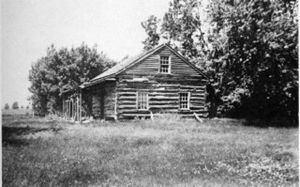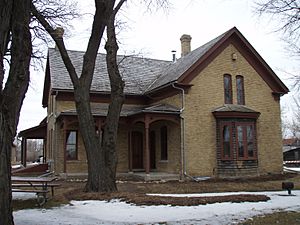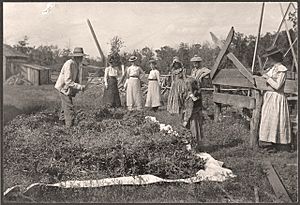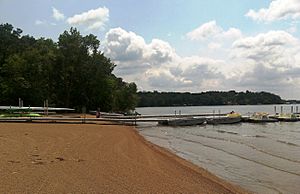Eden Prairie, Minnesota facts for kids
Quick facts for kids
Eden Prairie
|
|
|---|---|
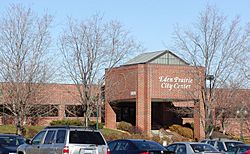
Eden Prairie City Center
|
|
| Nickname(s):
EP
|
|
| Motto(s):
Live, Work, Dream
|
|
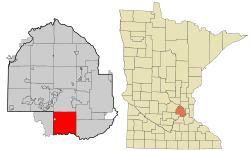
Location of Eden Prairie
within Hennepin County, Minnesota |
|
| Country | |
| State | |
| County | Hennepin |
| Founded | 1858 |
| Incorporated | October 22, 1962 |
| Founded by | Robert Anderson |
| Area | |
| • City | 35.22 sq mi (91.22 km2) |
| • Land | 32.50 sq mi (84.17 km2) |
| • Water | 2.72 sq mi (7.05 km2) |
| Elevation | 886 ft (270 m) |
| Population
(2020)
|
|
| • City | 64,198 |
| • Estimate
(2022)
|
62,476 |
| • Rank | US: 620th MN: 16th |
| • Density | 1,975.57/sq mi (762.76/km2) |
| • Urban | 2,650,890 (US: 16th) |
| • Metro | 3,693,729 (US: 16th) |
| Time zone | UTC-6 (Central (CST)) |
| • Summer (DST) | UTC-5 (CDT) |
| ZIP codes |
55344, 55346, 55347
|
| Area code(s) | 952|612 |
| FIPS code | 27-18116 |
| GNIS feature ID | 643164 |
| Airport | Flying Cloud Airport (Public/Reliever) |
| Interstates | |
| U.S. Routes | |
| State Routes | |
| County roads | |
| Public transportation | SouthWest Transit |
| Light rail | |
Eden Prairie is a city in Minnesota, United States. It is about 12 miles (19 km) southwest of downtown Minneapolis. In 2020, about 64,198 people lived there. This makes it the 16th-largest city in Minnesota. The city is next to the north bank of the Minnesota River.
Eden Prairie is part of the Minneapolis–Saint Paul area. This is the 16th-largest metropolitan area in the U.S. It has about 3.7 million people. The city was planned to be a place where people of different incomes could live. It has many businesses, including the main offices for companies like SuperValu and C.H. Robinson Worldwide.
The city is home to the Eden Prairie Center mall. It is also a main hub for SouthWest Transit, which provides public transportation. TV stations KMSP and WFTC are based here. A local news group called Eden Prairie Local News (EPLN) also serves the community.
Eden Prairie has many parks, nature areas, and trails. There are over 170 miles (270 km) of trails for walking and biking. The city has 2,250 acres (9 km2) of parks and 1,300 acres (5 km2) of open space. Popular spots include Staring Lake, Lake Riley, and the Minnesota River Bluffs Regional Trail.
Money magazine has often called Eden Prairie one of the "Best Places to Live" in America. It was ranked first in 2010 and second in 2016.
Contents
Exploring Eden Prairie's Past
For a long time, Eden Prairie was a small, quiet farming village. It was on the edge of the Twin Cities. Between 1880 and 1960, its population grew slowly. It went from about 739 people to 2,000.
Early Native American Life
Native Americans were the first people to live in this area. The land was originally part of the Great Dakota Nation. Later, the Ojibwe tribe arrived from the Great Lakes region. The two tribes sometimes had conflicts over the land.
In 1853, a town called Hennepin was planned along the Minnesota River. This was in what is now southeastern Eden Prairie. However, it was hard to transport farm goods from there. So, other towns grew instead, and Hennepin disappeared from maps.
Tribes continued to have conflicts over territory into the 1860s. This was even after the "Sioux Uprising" of 1862. After this, most Dakota people moved away from Minnesota.
One important Native American who lived in Eden Prairie was Chief Shoto. He was chief of the Red Wing Dakota tribe for 15 years. Later, he became chief of the "Little Six" band of Dakota. He also worked as a scout for Governor Sibley from 1862 to 1870. Chief Shoto died in 1899 at the age of 99 in his Eden Prairie home.
Pioneers and Growth
In 1851, a treaty opened land west of the Mississippi River for settlement. This allowed pioneers to move into what is now Eden Prairie. Many early farmhouses from this time are still standing. Some are even listed on the National Register of Historic Places.
One early settler was John Cummins, an immigrant from Ireland. He built the "Cummins-Phipps-Grill House" with his wife Mattie in 1880. John Cummins was a skilled farmer and scientist. He used his land to try growing different types of apples and grapes. He wanted to find ones that could survive Minnesota's tough climate. The Cummins family sold their farm to the Phipps family in 1908.
Eden Prairie's town board had its first meeting on May 11, 1858. This was the same day Minnesota became a state. The meeting took place in a log schoolhouse. In the 1870s, a post office called Washburn opened in Eden Prairie Township. It closed in 1903. Also, a train station was built along the Minneapolis-St. Louis Railroad. A new version of this old depot was built in 2022.
Eden Prairie's farming community grew slowly over the years. A big change came in 1946 with the building of Flying Cloud Airport. The 1960s and 1970s brought more growth for the city's parks and recreation. In the mid-1970s, the city became more well-known. This was due to the new Interstate Highway 494 and the Eden Prairie Center mall. Eden Prairie officially became a village in 1962 and a city in 1974. Staring Lake, a popular lake, is named after Jonas Platt Staring. He built the first house by the lake.
What's in a Name?
The city was first named "Eden" in 1853. A writer named Elizabeth F. Ellet chose the name. She admired the "beautiful prairie" in the southern part of the town.
Geography and Nature
Eden Prairie is about 11 miles (18 km) southwest of Minneapolis. It is located along the northern side of the Minnesota River.
Major roads in the city include Interstate 494, U.S. Highways 169 and 212. Minnesota State Highway 5 is also a main route.
Eden Prairie's land has rolling hills and bluffs that look over the Minnesota River. It has areas of prairie and mixed forests. These forests are mostly made up of deciduous trees. The city has many parks, like Staring Lake Park and Bryant Lakes Regional Park. These parks have trails for running and biking.
The city covers an area of about 35.19 square miles (91.14 km2). Most of this, about 32.45 square miles (84.05 km2), is land. The rest, about 2.74 square miles (7.10 km2), is water.
People of Eden Prairie
| Historical population | |||
|---|---|---|---|
| Census | Pop. | %± | |
| 1860 | 304 | — | |
| 1870 | 576 | 89.5% | |
| 1880 | 744 | 29.2% | |
| 1890 | 769 | 3.4% | |
| 1900 | 827 | 7.5% | |
| 1910 | 974 | 17.8% | |
| 1920 | 983 | 0.9% | |
| 1930 | 1,048 | 6.6% | |
| 1940 | 1,221 | 16.5% | |
| 1950 | 1,384 | 13.3% | |
| 1960 | 3,233 | 133.6% | |
| 1970 | 6,978 | 115.8% | |
| 1980 | 16,263 | 133.1% | |
| 1990 | 39,311 | 141.7% | |
| 2000 | 54,901 | 39.7% | |
| 2010 | 60,797 | 10.7% | |
| 2020 | 64,198 | 5.6% | |
| 2022 (est.) | 62,476 | 2.8% | |
| U.S. Decennial Census 2020 Census |
|||
Population in 2010
In 2010, there were 60,797 people living in Eden Prairie. There were 23,930 households and 16,517 families. The city had about 1,873.6 inhabitants per square mile (723.4/km2) people per square mile.
Most of the people (81.7%) were White. Other groups included African American (5.6%) and Asian (9.2%). About 3.0% of the population was Hispanic or Latino.
About 36.3% of households had children under 18. Most households (58.2%) were married couples. The average household had 2.53 people, and the average family had 3.08 people.
The average age in the city was 37.6 years old. About 26.4% of residents were under 18. And 8.6% were 65 or older. The city had slightly more females (51.5%) than males (48.5%).
Economy and Jobs
Eden Prairie is home to over 2,800 businesses. Many of these businesses work in areas like shipping, retail, health care, and technology.
Top Employers in Eden Prairie
Here are some of the biggest employers in the city, based on a 2016 report:
| # | Employer | # of Employees |
|---|---|---|
| 1 | Optum | 2,984 |
| 2 | Starkey Hearing Technologies | 1,700 |
| 3 | Eden Prairie School District #272 | 1,637 |
| 4 | SuperValu | 1,000 |
| 5 | C. H. Robinson Worldwide | 913 |
| 6 | Optum360, LLC | 900 |
| 7 | Lifetouch | 800 |
| 7 | MTS Systems Corporation | 800 |
| 8 | Eaton | 717 |
| 9 | Abbott Laboratories | 617 |
The video game store FuncoLand used to have its main office in Eden Prairie. It had over 400 stores across the country.
Arts, Culture, and Sports
Eden Prairie Veterans Memorial
In 2008, the community raised about $500,000 to build a veterans memorial. It is located in Purgatory Creek Park. The memorial has two parts: one for service to country and one for world peace.
Sculptor Neil Brodin created two bronze statues for the memorial. One statue shows a soldier carrying a wounded airman. The other statue shows a woman service member touching a globe. This honors women who have served. People could buy a spot on the memorial to honor family members who served in the U.S. military. The memorial walls are made of black granite.
Sports Events
The 2017 USA Rink Bandy League Cannon Cup Playoffs were held at the Eden Prairie Rinks.
Education in Eden Prairie
Public Schools
The first school in Eden Prairie was Anderson School. It was a schoolhouse near a farm. The old Eden Prairie Consolidated School, built in 1924, is now the school district's main office. It is next to Central Middle School.
Eden Prairie has eight K-12 schools. There are six elementary schools (PreK-5), including one that teaches in Spanish. There is one middle school (6-8) and one high school (9-12). Eden Prairie High School is the fifth-largest high school in Minnesota. It has about 2,600 students. It is near Round Lake Park and the Eden Prairie Community Center.
List of Public Schools
- Oak Point Elementary
- Prairie View Elementary
- Cedar Ridge Elementary
- Forest Hills Elementary
- Eden Lake Elementary
- Eagle Heights Spanish Immersion
- Central Middle School
- Eden Prairie High School
The school district has a strong record of success. For example, 11 juniors from Eden Prairie High School got perfect scores on the ACT test in 2017. Some students can choose to attend public schools in other districts. This is allowed under Minnesota's open enrollment law.
Charter Schools
As of the 2017–18 school year, Eden Prairie has one charter school. It is called the Performing Institute of Minnesota Arts High School.
Private Schools
Eden Prairie has one private school, The International School of Minnesota. This school offers education for students from preschool through 12th grade. It prepares students for college. The school was founded in 1985. It teaches world languages every day starting in preschool. It also offers 19 advanced placement (AP) courses for older students. Most students (85%) are local residents, and 15% are international students.
Colleges
There is one technical college campus in Eden Prairie. Hennepin Technical College has about 7,000 full-time and part-time students. It offers classes during the day and at night. Its main campus is in Brooklyn Park, Minnesota.
City Services
The city has its own police department. The Canadian Pacific Kansas City (Soo Line) train line also serves the city.
Famous People from Eden Prairie
Many interesting people have connections to Eden Prairie:
- Andrew Alberts – An ice hockey player for the Vancouver Canucks.
- Leith Anderson – A former president of the U.S. National Association of Evangelicals.
- Adam Bartley – An actor.
- David Baszucki – The CEO and co-founder of Roblox.
- Rachel Bootsma – An Olympic swimmer.
- Jasper Brinkley – A football player for the Minnesota Vikings.
- Laurie Coleman – An actress and wife of former U.S. Senator Norm Coleman.
- Todd Downing – A former offensive coordinator for NFL teams. He was born in Eden Prairie.
- Chuck Foreman – A former football player for the Minnesota Vikings.
- Dan Gladden – A former MLB baseball player for the Minnesota Twins. He is now a radio broadcaster for the Twins.
- Jermaine Johnson II – A defensive end for the New York Jets.
- Nick Leddy – A defenseman for the New York Islanders.
- Casey Mittelstadt – A National Hockey League player.
- Reynold Philipsek – A jazz guitarist.
- Allison Pottinger – A world champion curler.
- Kyle Rau – A forward for the Florida Panthers.
- Robert Remus – Also known as Sgt. Slaughter, a famous wrestler.
- William Sawalich – A racing driver.
- Malik Sealy – A former guard for the Minnesota Timberwolves.
- Nick Seeler – A defenseman for the Philadelphia Flyers.
- Sheila E. – A singer-songwriter and percussionist.
- Kenny Stills – A wide receiver for the Miami Dolphins. He was born in Eden Prairie.
- Charlie Vig – The chairman of the Shakopee Mdewakanton Sioux Community.
Images for kids
See also
 In Spanish: Eden Prairie (Minnesota) para niños
In Spanish: Eden Prairie (Minnesota) para niños




